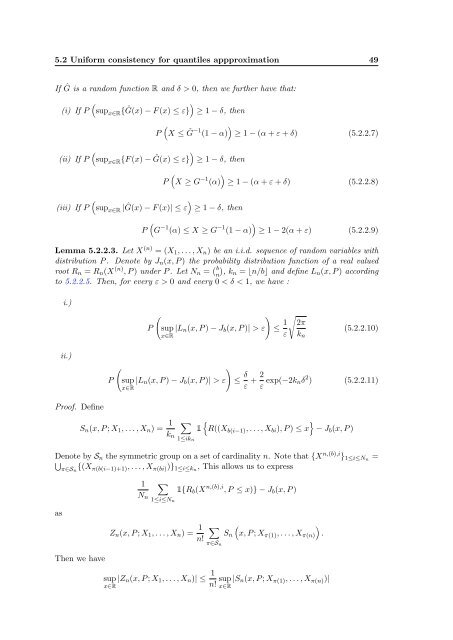Subsampling estimates of the Lasso distribution.
Subsampling estimates of the Lasso distribution.
Subsampling estimates of the Lasso distribution.
Create successful ePaper yourself
Turn your PDF publications into a flip-book with our unique Google optimized e-Paper software.
5.2 Uniform consistency for quantiles appproximation 49<br />
If Ĝ is a random function R and δ > 0, <strong>the</strong>n we fur<strong>the</strong>r have that:<br />
)<br />
(i) If P<br />
(sup {Ĝ(x) − F (x) ≤ ε} x∈R ≥ 1 − δ, <strong>the</strong>n<br />
)<br />
(ii) If P<br />
(sup x∈R {F (x) − Ĝ(x) ≤ ε} ≥ 1 − δ, <strong>the</strong>n<br />
)<br />
(iii) If P<br />
(sup |Ĝ(x) − F (x)| ≤ ε x∈R ≥ 1 − δ, <strong>the</strong>n<br />
P<br />
P<br />
(<br />
)<br />
X ≤ Ĝ−1 (1 − α) ≥ 1 − (α + ε + δ) (5.2.2.7)<br />
P<br />
(<br />
)<br />
X ≥ G −1 (α) ≥ 1 − (α + ε + δ) (5.2.2.8)<br />
(<br />
)<br />
G −1 (α) ≤ X ≥ G −1 (1 − α) ≥ 1 − 2(α + ε) (5.2.2.9)<br />
Lemma 5.2.2.3. Let X (n) = (X 1 , . . . , X n ) be an i.i.d. sequence <strong>of</strong> random variables with<br />
<strong>distribution</strong> P . Denote by J n (x, P ) <strong>the</strong> probability <strong>distribution</strong> function <strong>of</strong> a real valued<br />
root R n = R n (X (n) , P ) under P . Let N n = ( b<br />
n) , kn = ⌊n/b⌋ and define L n (x, P ) according<br />
to 5.2.2.5. Then, for every ε > 0 and every 0 < δ < 1, we have :<br />
i.)<br />
ii.)<br />
P<br />
(<br />
P<br />
(<br />
sup |L n (x, P ) − J b (x, P )| > ε<br />
x∈R<br />
sup |L n (x, P ) − J b (x, P )| > ε<br />
x∈R<br />
)<br />
)<br />
≤ 1 ε<br />
√<br />
2π<br />
k n<br />
(5.2.2.10)<br />
≤ δ ε + 2 ε exp(−2k nδ 2 ) (5.2.2.11)<br />
Pro<strong>of</strong>. Define<br />
S n (x, P ; X 1 , . . . , X n ) = 1<br />
k n<br />
∑<br />
1<br />
1≤ik n<br />
{<br />
}<br />
R((X b(i−1) , . . . , X bi ), P ) ≤ x − J b (x, P )<br />
Denote by S n <strong>the</strong> symmetric group on a set <strong>of</strong> cardinality n. Note that {X n,(b),i } 1≤i≤Nn =<br />
⋃<br />
π∈S n<br />
{(X π(b(i−1)+1) , . . . , X π(bi) )} 1≤i≤kn , This allows us to express<br />
as<br />
Then we have<br />
1<br />
N n<br />
∑<br />
1≤i≤N n<br />
1{R b (X n,(b),i , P ≤ x)} − J b (x, P )<br />
Z n (x, P ; X 1 , . . . , X n ) = 1 n!<br />
sup<br />
x∈R<br />
∑ (<br />
)<br />
S n x, P ; X π(1) , . . . , X π(n) .<br />
π∈S n<br />
|Z n (x, P ; X 1 , . . . , X n )| ≤ 1 n! sup |S n (x, P ; X π(1) , . . . , X π(n) )|<br />
x∈R
















